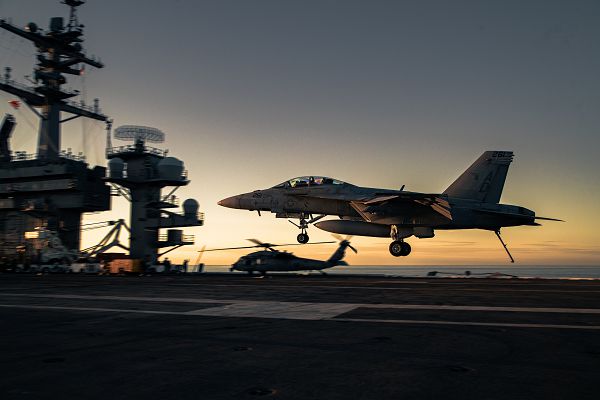
Atlantic Ocean. (November 12, 2023): Pilots call it a “controlled crash landing” and it is one of the most dangerous tasks military aviators face every day. In this photo by MC2 Nicholas Russell, an F/A-18F Super Hornet attached to Strike Fighter Squadron 106 lands aboard the Nimitz-class aircraft carrier USS George Washington while the ship is underway.
Imagine flying a high-speed combat aircraft in foul weather and having to land on a rolling, pitching runway that is only five hundred feet long. Oh, and did I mention this feat is often accomplished at night in total darkness.
The process begins when the Landing Signal Officer aboard the carrier clears the pilot to land. In a normal scenario, various returning planes “stack up” in the skies above the carrier and are granted permission to land by the Carrier Air Traffic Control Center based on their fuel level. Once given the ok, pilots break from their circulating pattern, release their tailhook, and head toward the stern of the ship.
The goal is to grab one of four “arresting” wires or cables strung across the landing area spaced about fifty feet apart and connected to a series of hydraulic pulleys below deck. Pilots typically aim for the third wire as it is the safest target. Aviators avoid the first wire as it is dangerously close to the end of carrier deck and, if they are too low, could cause them to crash into the stern of the ship. To be qualified to fly from a carrier, pilots must demonstrate they can hit the third wire consistently in all weather conditions day and night.
To pull off this “crash landing,” pilots must approach the landing area at exactly the right angle. To do this, pilots rely on a Fresnel Lens Optical System, or “Lens,” that consists of a series of lights mounted to a gyroscope for stability on a pitching deck. The Lens directs these lights at various angles into the sky and pilots will see different lights depending upon their angle of approach. If they are right on target, pilots will see an amber light, colloquially referred to as the “meatball,” along with a row of green lights. If the meatball is above the set of green lights, the plane is coming in too high. If the amber light is below the set of green lights, the plane is coming in too low. If the pilot’s trajectory is way too low, the Lens transmits a red light to the pilot to wave off and come around again.
Once pilots hit the deck, they do something that appears irrational… they accelerate. They do this in case their tailhook doesn’t catch any of the arresting wires and they may need to take off again and make another try. As soon as the plane lands, a highly sophisticated team of Sailors tightly secures the aircraft to shifting deck.
These “controlled crash landings,” and the daring pilots that perform them, allow America to project power anywhere in the world.


